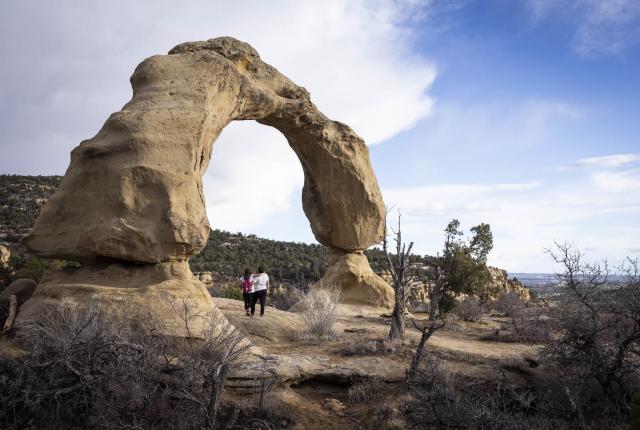I’M STANDING AT WHAT was once the bottom of the ocean and where tyrannosaurs used to roam. Here, too, an Ancestral Puebloan mother likely played hide-and-seek with her young son among the boulders. Poised on a mesa in Aztec, with views of Cox Canyon Arch, piñon trees, and snow-capped mountains in the distance, I imagine the long legacy of the land beneath me.
“Freedom!” shouts Johnathan Dobbs, owner of Mountain View Experiences and my hiking guide for the day. “That’s the feeling I get hiking out here.” A math teacher at Piedra Vista High School, in Farmington, Dobbs established the hiking-tour company in 2020 and opened a tent campground on a 33-acre property outside Aztec the following year.
With more than a million acres of public land in the Farmington, Bloomfield, and Aztec areas and the large network of oil and gas access roads, the outdoor playground is nearly boundless. Hiking opportunities range from gentle paved paths along the Animas River in both Aztec and Farmington to otherworldly treks through the Bisti/De-Na-Zin Wilderness’s weathered hoodoos, spires, and rock formations.
“If you see a cool rock you want to climb,” Dobbs adds, “you can just go.”
Earlier that morning, he took me to two different arches off backcountry dirt roads. “What’s the name of this one?” I ask, as I stretch my arms out like a starfish, posing for a photo under an eight-foot natural arch. “I’m not sure there is a name for this one,” Dobbs replies, admiring its strange form.
Arches in Aztec are like stars in the sky—almost innumerable. Partnering with the Natural Arch and Bridge Society, the town has identified, classified, and geotagged more than 300 naturally occurring arches—rock exposures with a hole formed by erosion of rock, leaving a relatively intact frame—in the area. Since many more remain to be registered, it’s no wonder my guide didn’t know the arch’s name.
Since moving to Aztec in 2012, Dobbs has found many secret spots by exploring with his two kids. “I just love showing locals places, like Cutter Dam Reservoir, they didn’t even realize were here.” That was my case. I grew up in Aztec but didn’t know about these surreal sandstone windows until today—30 years after I left home.
While making up for lost time, I had to see Cox Canyon Arch, the area’s most famous example that gets printed on brochures and billboards. Called New Mexico’s version of Delicate Arch in Moab, Utah, Aztec’s largest formation looms 35 feet tall and spans 42 feet wide. The hike takes roughly 30 minutes round trip with an easy switchback trail to the left of the trailhead, which is ideal if you’re with kids or dogs. To the right, there’s a route with some scrambling involved. “Let’s do the fun one,” Dobbs suggests, gesturing to the tougher path. Along the way, he points out more fun to be had, from rock tunnels to a geocached treasure.
Finally, there she is. Standing magnificently giant and glimmering golden, this rainbow-shaped rock formation seems to be hung from the heavens above, suspended with invisible wires. Yet it’s not. The Cox Canyon Arch stands on her own two feet, or boulders, I should say. Dobbs has been to the Cox Canyon Arch dozens, if not hundreds, of times leading Boy Scout troops and tourists, but even he takes a moment of silence, craning his neck and looking up in wonder.
“People pass through the area on the way to somewhere else, be it Moab or Durango,” reflects Dobbs. “They have no idea of the awesome beauty they’re missing.”




